This site is supported by our readers. We may earn a commission, at no cost to you, if you purchase through links.
Have you ever wanted to get rid of an old iron-on patch from your clothing but weren’t sure how? Well, now you can! In this article, we’ll go over the different methods and solvents that one could use to safely and effectively remove those pesky patches.
We’ll also provide some helpful tips on what not to do when trying to get at those hard-to-remove pieces.
So let’s dive in and find out exactly how easy it can be for anyone with a little patience or even experience with removing iron-ons off shirts.
Table Of Contents
- Ways to Remove an Iron-on Transfer From Clothes
- Solvent Spraying
- Stretch and Peel
- Heat Loosening
- Sharp Knife Scraping
- High Heat Ironing
- Chemical Solvent Purchasing
- High Heat Drying
- Saturating With Solvent
- Towel and Flat Surface Method
- Additional Information
- Patch Removal Process
- Glue Residue Removal
- Fragment Removal
- Author and Article Information
- User Testimonial
- How to Get Iron on Off a Shirt
- Heat Your Iron
- Place Your Parchment Paper
- Move Your Iron
- Clean Up
- Frequently Asked Questions (FAQs)
- Conclusion
Ways to Remove an Iron-on Transfer From Clothes
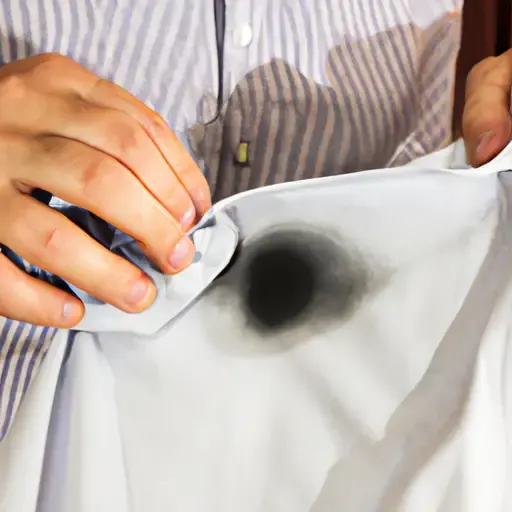
When using heat to remove an iron-on transfer from clothes start by placing your garment on a flat surface with another cloth underneath in case any glue residue is left behind. Then set your iron at its highest setting that is appropriate for both materials used- use caution when doing this! Place some parchment paper over top of where you want to remove the patch then place it back down onto shirt before pressing down firmly with quick strokes until all parts have been heated up enough so that adhesive has loosened up significantly making it easier to peel off or scrape away without leaving too much mess behind.
Solvent Spraying
Spraying a solvent like acetone, rubbing alcohol, or Goo Gone can help loosen and remove the patch from the fabric. To do this effectively, it is important to soak the garment for at least 10 minutes in water first.
This helps ensure that any adhesive residue loosens enough to be removed with ease. When spraying your chosen solvent on either side of the patch, make sure you wear protective gloves as some solvents can cause skin irritation or damage clothing fibers if used incorrectly.
Once sprayed generously with your preferred solvent solution let it sit for several minutes before attempting to scrape off any remaining pieces of adhesive using gentle scraping techniques such as a butter knife or credit card edge being careful not avoid causing fabric tears which could happen during aggressive scraping attempts.
After removing excess glue residue by water soaking and/or spraying solvents onto both sides of iron-on patches followed by gently scraping techniques one should also consider applying stain prevention products specially designed for fabrics right after cleaning so that no further staining occurs due discoloration caused by leftover chemicals residues when dealing with stubborn adhesives used on iron-on transfers found in apparel items such as t-shirts and sweatshirts.
Stretch and Peel
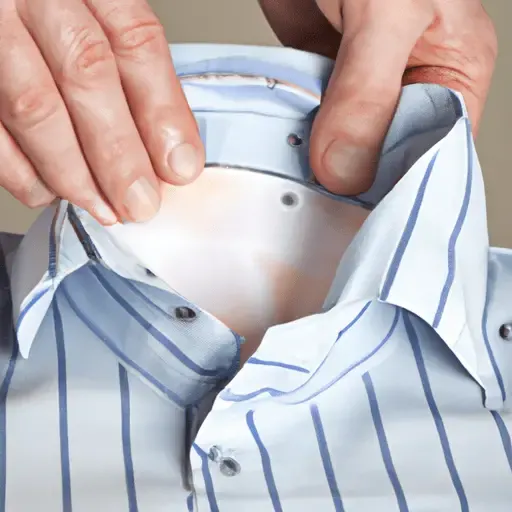
It might take some patience but eventually you will be successful in getting rid of your unwanted decoration.
Be sure to check what material types are used for both your garment and adhesive before proceeding with this method — heat settings may need adjusting depending on these factors too — as well as being mindful about where you place any patches (e.
Heat Loosening
By loosening up the adhesive with heat, you can easily peel away the transfer without damaging your garment. One way to do this is by soaking or steaming your clothing item until it’s damp and then using a sharp object like an edge of a spoon or knife to carefully pry off the patch from one corner at a time.
Another option is freezing; if temperatures are low enough, simply place your garment in the freezer for about 30 minutes before peeling off. If that doesn’t work boiling water over it may help loosen up any remaining bits of glue so they can be scraped away with rubbing alcohol once cooled down again.
With patience and care you should have no problem removing iron-on patches quickly while preserving clothes beneath them intact!
Sharp Knife Scraping
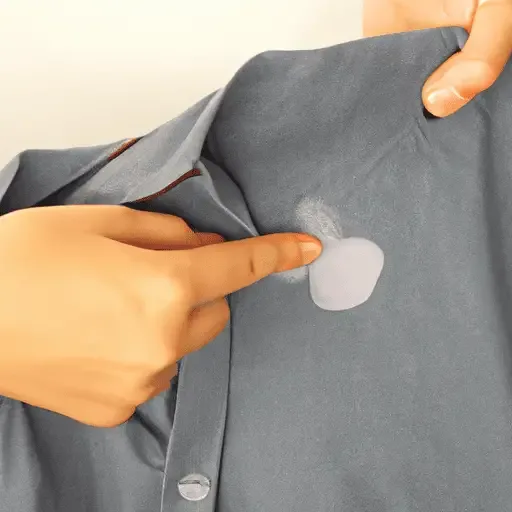
It is also essential to ensure that there is heat control when scraping with a knife – if heated too much, patches will not be able to be replaced and residue left behind may become difficult to clean up.
With patience and care however, this method can provide successful results in removing an iron-on patch from clothing without ruining your garment! Be sure take all necessary safety precautions when working with sharp objects such as wearing gloves or eye protection during use as well as keeping out of reach of children at all times.
High Heat Ironing
To effectively rid your garment of the iron-on transfer, grab an iron at a high heat setting and place a sheet of parchment paper over the patch before quickly stroking it with the hot device to melt away any adhesive.
This method has been viewed 1,494,486 times on wikiHow for its quality results and time commitment – making it one of the most popular ways to remove an iron-on transfer from clothes. It is important to note that different types of irons will require different levels or temperatures when applying heat protection; therefore safety precautions should always be taken prior to starting this process.
Additionally, patience may be required as certain patches can take longer than others to loosen up due their size or age.
Chemical Solvent Purchasing
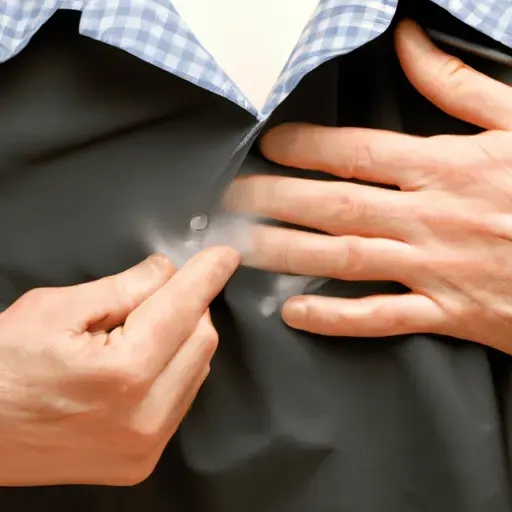
When selecting a product, it is important to consider its chemical properties and types of solvents available on the market.
- Understand what type of adhesive you are dealing with so that you can select an appropriate solvent for removal without causing surface damage or discoloration.
- Familiarize yourself with different application techniques when handling these products since some require extra protection such as gloves and masks in order to avoid any potential skin reactions due diligence must be taken when purchasing them from reliable sources like specialty stores or online vendors who specialize in selling industrial strength chemicals used for removing lettering from fabrics safely and effectively while minimizing any risk involved in their use. Finally, once selected appropriately follow all instructions listed on packaging before applying solution directly onto cloth garment carefully read through warning labels included inside container prior starting process ensure optimal results!
High Heat Drying
Placing the garment in a dryer on high heat for a few minutes can be an effective way to loosen and remove an iron-on transfer, like turning up the dial of success. This technique works best when combined with other methods such as solvent spraying, patch removal or heat loosening.
While it may not completely get rid of glue residue left behind from patches, this method is useful for softening the adhesive so that it peels off more easily than if you were to just try and scrape it away with your fingernail alone.
It’s also important to remember to check your garment care instructions before heating as some materials can shrink or become damaged if exposed directly to high temperatures.
Saturating With Solvent
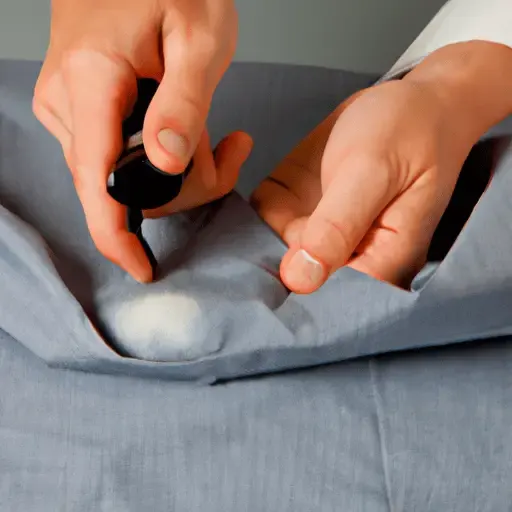
Also note that different types of adhesives respond differently at various temperatures and settings when exposed to heat or steam from an iron or hairdryer. If possible, check with manufacturer instructions before using any chemicals as some fabrics may react adversely with certain solutions such as acetone or rubbing alcohol if left on too long.
When attempting this method always ensure your work surface is covered either by newspaper or parchment paper so there are no spills while soaking clothes – especially if working indoors! Depending on how stubbornly stuck down the transfer is will determine how long it needs to be soaked in order for all traces of glue residue come off easily once peeled away from its backing material.
Towel and Flat Surface Method
Placing the garment on a flat surface and tucking in a towel within it is an effective way to loosen the adhesive of an iron-on patch, allowing it to be peeled away with ease. This fading technique not only reduces heat damage but also enables steam cleaning and lint removal while blocking stains from sinking into fabric.
To achieve this effect, start by turning your garment inside out so that you can see the back of where the patch was applied. Then place a piece of parchment paper over it before using quick strokes with your iron at medium or high heat depending on how strong your material is; make sure to check its care instructions first! The hot air should help soften up any remaining glue residue which will then allow you to pull off any fragmentary patches left behind without worrying about tearing or damaging them further.
Additional Information
I know all about iron-on patches and how to apply them. Firstly, you need heat-activated glue which can be found in most craft stores or online. Secondly, place the patch on your garment and cover it with a piece of cloth or parchment paper before running an iron over it for several seconds- this will activate the adhesive so that your patch stays put.
Iron-on Patch Application
Applying iron-on patches is a simple task that can instantly personalize any garment, though it’s important to be aware of the fabric type and temperature setting when doing so. Patch placement should always take into consideration where the patch will sit most comfortably on the clothing item; this could mean near seams or away from them.
Heat levels depend on whether you’re working with natural fabrics like cotton, wool and silk or synthetic fibers such as polyester and acetate — each require different temperatures for effective adhesion.
When using an iron, make sure to control your heat settings as too much heat may cause damage to certain fabrics while not enough won’t adhere properly at all! Pressure application also plays a role in achieving successful results; applying gentle pressure helps get rid of air bubbles between fabric layers without distorting design elements within your patch itself.
Patch Removal Process
Peeling away an iron-on patch can be a tedious process, but with the right tools and techniques it’s possible to remove them quickly and easily. High quality patches will often adhere better than lower quality ones, so if you have trouble removing your patch make sure to check the label for any special instructions or materials used in its construction.
The most common technique is simply stretching out the fabric surrounding the patch then peeling or scratching off as much of it as possible before washing. Another method involves using heat from either a hair dryer on high setting or steaming hot towel over where you want to loosen up that glue bond enough for easier removal without damaging your clothes underneath.
As another alternative, chemical solvents like acetone are available which many people prefer due their effectiveness with all types of lettering designs found on clothing labels such as vinyl transfers, screen prints & embroideries plus they dissolve adhesive residue after successful removal too! Lastly don’t forget always read garment care instructions beforehand when trying any methods mentioned here just in case there might be different requirements depending on material type etc.
With these tips at hand now anyone should feel confident tackling this task today – happy iron-on removals everyone!
Glue Residue Removal
After peeling off the patch, use a fabric-safe adhesive remover to tackle any stubborn glue residue. If this method doesn’t work, then you can try using scorching temperatures with friction techniques or chemical solutions.
You can also try tape removal methods or steam penetration for more difficult patches. All of these options are effective and should help remove the remaining glue from your shirt after removing the patch.
Be sure to read all instructions carefully before attempting one of these methods as some may require special precautions such as wearing protective gear while working with chemicals or adhesives that could be hazardous if not handled properly.
Fragment Removal
If any remaining fragments remain, lightly spritz the shirt with water and place a sheet of Teflon over the transfer, then press it again to help remove them.
Author and Article Information
The article was written by Rani Gorgis, a Laundry and Cleaning Specialist and Owner of Park Blvd Laundry & Dry Cleaners in San Diego, California; it has been viewed
- 4 million times and co-authored by 19 people since its last update on February 26th,
- To remove an iron-on patch safely without damaging the fabric underneath requires knowledge of proper Iron on Patch Care as well as Glue Residue Cleaning techniques which can be applied with Applying Heat with Parchment Paper Use to Fragment Removal effectively. When doing this process for removal it is important to remember that patience will be needed due to the lengthier time required for complete removal but when completed correctly you should have no further fragments remaining after washing your garment separately from other clothing items.
User Testimonial
Users have found the article to be a lifesaver and are thankful for its helpful instructions that allowed them to successfully remove iron-on patches from their garments. The key is to understand when it comes to stain removal; fabric damage can occur easily if proper methods aren’t used.
It’s important to use an appropriate temperature on the iron and take extra precautions, like using a heat gun or covering your patch with parchment paper before applying direct heat. If you’re not sure about safety measures, always check your garment care instructions first before taking any drastic steps or trying out new techniques.
How to Get Iron on Off a Shirt
Peeling and scraping away the patch with a sharp object, or using heat to loosen it can be an effective way of removing any iron-on transfers from clothes. There are several methods that one might use such as solvent spraying, heat loosening, sharp knife scraping and chemical solvents.
Solvent sprays like acetone or rubbing alcohol are usually best for patches which have been applied recently as they help break down the adhesives used. Heat is also another great option since it will cause the adhesive to soften making removal easier – this can come in form of a hair dryer or steam from hot towels being placed overtop of the transfer area.
Heat Your Iron
I’m here to teach you how to get an iron-on off a shirt. First, heat your iron up to its highest setting and cover the patch with parchment paper or cloth. Then quickly press down onto it, making sure the temperature of the iron is just right for label removal and that there is no movement of your hand as you do this process.
With each pass over the transfer, more glue will be loosened until eventually all that’s left is some residue on top of your garment which can then be removed with rubbing alcohol or adhesive remover applied directly onto it.
Place Your Parchment Paper
Place a sheet of parchment paper carefully over the patch, then gently iron it with quick strokes to begin melting the adhesive. This technique requires attention to detail and knowledge of proper clothing care when using heat settings on different materials.
When choosing an appropriate temperature for your garment, consider its fabric type and whether or not you have any special instructions from the manufacturer. Depending on how thick your patch is, this method should take anywhere from five seconds up to two minutes per spot in order for all patches are removed properly without damaging your clothes underneath it.
To ensure that no permanent damage is done during removal process make sure that you don’t exceed recommended time limits as well as stay within necessary heat settings range determined by each material’s sensitivity level towards heat exposure particular types may require lower temperatures than others do since they can get damaged very easily if heated too much at once while transferring energy onto them directly through hot tools such as irons which used here in combination with parchment paper pieces placed between those layers where glue holds everything together before releasing everything back into air after few seconds due direct contact between both objects (iron & cloth).
Move Your Iron
Removing an iron-on label can be a tricky task, but with the right information and tools it’s easy to do. I’ve found that using solvents like acetone or Goo Gone are great for loosening up the adhesive on labels, while heat from a hair dryer or steam from a hot towel works well to soften them.
Scraping off any remaining residue with a sharp knife is also effective, followed by washing your garment as usual afterwards.
Remove Your Iron-on Label
Carefully peeling and stretching the fabric, you can gradually remove your iron-on label with ease. Using rubber removal methods like a nail file or rubbing alcohol to break down the adhesive is an effective way to get it off without damaging the surface of your shirt.
You could also use distressing techniques such as sandpaper, steel wool, or pumice stones for more stubborn patches that won’t come off easily. Ironing tips such as pre-treatments and natural remedies might be necessary if these don’t work either.
For example, place a damp cloth over top of patch before pressing firmly on it with an iron heated at high temperatures will help loosen up any glue residue left behind after scraping away at the patch itself firstly by hand then using a sharp knife when needed.
Whatever technique you choose; make sure not to rush through it in order avoid causing further damage to clothing item!
Clean Up
Clean up any remaining residue by saturating the garment with a fabric-safe adhesive remover, then wiping away with rubbing alcohol. Before you start ironing your clothes, it’s important to understand the basics and get familiarized with all of the heat settings available on your clothing iron.
If there are any stains present before you begin to press them out, pre-treating is also recommended for better results in getting rid of dirt or grease spots. Ironing can be tricky so make sure that when using an iron on delicate fabrics like rayon or silk – always use low heat settings and never put pressure when pressing down as this could cause damages such as burn marks! Also avoid repeating strokes over one area too many times which may reduce fabric quality significantly over time due to extreme exposure from high temperature levels.
Frequently Asked Questions (FAQs)
What types of fabric are best for iron-on transfers?
When it comes to iron-on transfers, the fabric you choose can make all the difference. Choosing a suitable fabric is key for successful patch removal and avoiding damage to your clothing. When selecting a fabric, consider its ability to withstand heat and pressure; natural fibers like cotton or linen are best as they have better tensile strength than synthetic fabrics such as polyester or nylon.
In addition, be sure that your chosen fabric can handle high temperatures when setting with an iron – otherwise it will scorch easily! Lastly, always follow proper preparation guidelines: prewash any new garment before applying an iron-on transfer and test the temperature of your iron on scrap material first before pressing down onto garments! If done correctly these steps should result in success when using different methods such as Iron Temperatures, Iron Placement Fabric Preparation Patch Removal Heat Transfer techniques for optimal results with minimal effort involved.
Can I use an iron-on transfer on any type of clothing?
Iron-on transfers can be applied to most types of clothing, but the durability and adhesive strength depend on the fabric type. Cotton is ideal for iron-ons because it’s sturdy and has a tight weave that allows for good adhesion; polyester also works well as long as you use an industrial heat press instead of an iron.
For best results, ensure your garment is clean before applying the transfer and follow any directions included with your product carefully. Additionally, when removing iron-on patches from clothes make sure to have all necessary supplies like acetone or Goo Gone ready beforehand in order to prevent damaging the fabric or leaving behind glue residue.
What temperature should I set my iron to for iron-on transfers?
When applying an iron-on transfer to your clothing, it’s important to know the proper temperature setting for your iron. The ideal temperature depends on several factors such as the material of the garment, the properties of your design, and its heat resistance.
A good rule of thumb is to set your iron between medium and high heat; use a lower setting if you are working with delicate fabrics like silk or rayon. You should also consider how adhesive quality will affect how well it sticks- higher temperatures may lead to better adhesion but too much can damage both fabric and image.
Is it safe to use an iron-on transfer on delicate fabrics?
Iron-on transfers can be a great way to add some personal flair to your clothing, but it is important to consider the fabric type and transfer technique before applying the patch. Delicate fabrics like silk and rayon should generally not be used for iron-on patching as they may become damaged from too much heat or glue removal.
For best results, make sure you use an appropriate heat setting on your iron that won’t damage delicate fabrics and use sharp tools when removing any remaining glue residue.
How long can an iron-on transfer last?
Iron-on transfers are an easy and fun way to customize your clothes. Their sticking power usually depends on the fabric type, care instructions, iron temperature used for application and washing tips afterwards.
For best results, it’s important to choose a fabric that is compatible with the transfer material you’re using. It’s also important to follow care instructions when applying with an iron or heat press at the right temperature setting; otherwise, you may end up removing it again sooner than expected! To ensure your design lasts as long as possible, wash garments inside out in cold water and tumble dry low or hang them up after each use.
Conclusion
I’m sure you’re feeling relieved now that you’ve removed your iron-on transfer from your clothing. It can be quite a hassle to get rid of these patches and you should be proud of yourself for tackling it so successfully.
With the proper preparation and a bit of patience, you can now enjoy your clothing without any annoying patches. My advice is to keep this knowledge handy in case you ever encounter this problem again.
As they say, forewarned is forearmed. With the right instructions and the right tools, you’ll be able to get rid of any iron-on transfer in no time.






